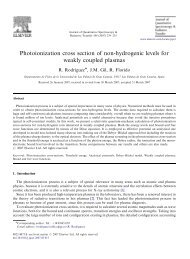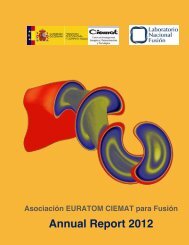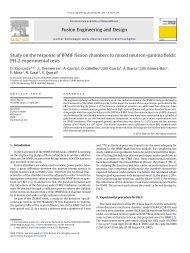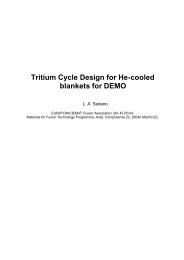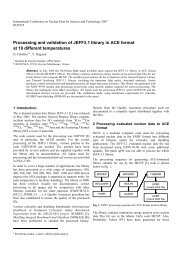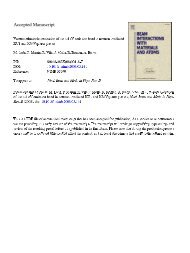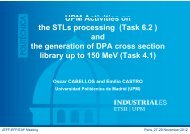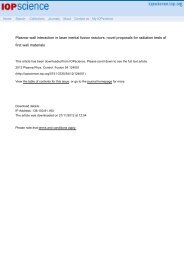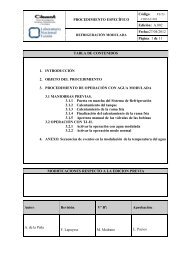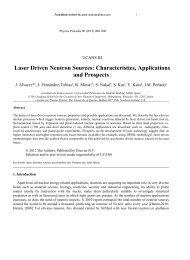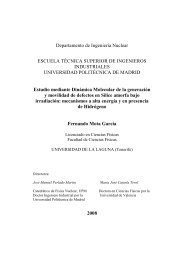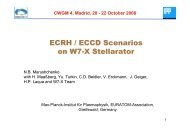NTR_2 - Ciemat
NTR_2 - Ciemat
NTR_2 - Ciemat
You also want an ePaper? Increase the reach of your titles
YUMPU automatically turns print PDFs into web optimized ePapers that Google loves.
G Model<br />
FUSION-6709; No. of Pages 5<br />
ARTICLE IN PRESS<br />
Fusion Engineering and Design xxx (2013) xxx–xxx<br />
Contents lists available at SciVerse ScienceDirect<br />
Fusion Engineering and Design<br />
journa l h o me page: www.elsevier.com/locate/fusengdes<br />
Assessment of radiation dose due to the accidental release of radionuclides from<br />
a DCLL reactor<br />
Iole Palermo a,∗ , J.M. Gómez-Ros a , J. Sanz b , F. Mota a<br />
a CIEMAT, Avda. Complutense 40, 28040 Madrid, Spain<br />
b Departamento de Ingeniería Energética, UNED, C/Juan del Rosal 12, 28040 Madrid, Spain<br />
h i g h l i g h t s<br />
◮ Accidental release of radionuclides from a Dual-Coolant He/Pb15.7Li breeding blanket is studied.<br />
◮ Activation analysis with ACAB code determines the main contributors to the environmental consequences of the accident.<br />
◮ Atmospheric dispersion (in conditions D and F) is assessed with Hotspot code for the relevant radionuclides.<br />
◮ The actual quantity of each radionuclide produced in 1 kg of LiPb is used in the dispersion model.<br />
◮ The amount of LiPb releasable fulfilling the dose limit requirements is calculated.<br />
a r t i c l e i n f o<br />
Article history:<br />
Available online xxx<br />
Keywords:<br />
DEMO<br />
LiPb<br />
Activation analysis<br />
Environment studies<br />
a b s t r a c t<br />
A conceptual design for a DEMO fusion reactor based on a dual coolant He/Pb15.7Li breeding blanket<br />
(DCLL) is being developed within the Spanish Breeding Blanket Technology Programme: TECNO FUS. The<br />
production of tritium and activation products of LiPb might be a concern from the radiological safety<br />
point of view. Thus, in this contribution, an accidental release in atmosphere of radionuclides from LiPb<br />
breeder has been studied.<br />
Activation calculations have been performed with ACAB code assuming an irradiation scenario of 5 FPY<br />
for the maximum neutron fluence rate in the equatorial breeding zone. The results in terms of specific<br />
activity, surface gamma dose rate and committed effective dose (CED) due to inhalation at different times<br />
have been used to chose the potentially more hazardous radionuclides.<br />
Dispersion of the selected radionuclides has been modeled with HOTSPOT code using the Gaussian<br />
plume model and two different atmospheric conditions. Offsite dose (for external irradiation and inhalation)<br />
due to an accidental release of 1 kg of activated LiPb has been calculated after 5 FPY of irradiation<br />
(shutdown) using HOTSPOT atmospheric dispersion in class D weather conditions. According to the<br />
results, fulfilling the dose requirement for no evacuation would permit to release up to 40 kg of activated<br />
LiPb, without taking into account the possible isotopic purification and detritiation systems. This<br />
value can be compared with the actually released amount in a given accidental scenario for designing<br />
the reactor confinement barriers and safety systems.<br />
© 2013 Elsevier B.V. All rights reserved.<br />
1. Introduction<br />
A conceptual design of a DEMO fusion reactor based on a dual<br />
coolant He/Pb15.7Li breeding blanket (DCLL) is being developed<br />
within the frame of Spanish research project TECNO FUS. Because<br />
of the high neutron fluence rate, the potential release of activation<br />
products from the coolant up to the atmosphere can be a concern<br />
from radiation protection point of view in case of accident.<br />
In this work, a first radiation assessment in terms of the potential<br />
early dose to the maximally exposed individual (MEI) has been<br />
performed. This study is focused on the analysis of the major radiological<br />
inventory in the breeding material and the atmospheric<br />
dispersion of released radionuclides from damaged breeding modules<br />
to the environment. The source terms have been evaluated in<br />
a parametric way in order to estimate the maximum quantity of<br />
releasable LiPb.<br />
2. DCLL model and neutronic calculation<br />
∗ Corresponding author at: CIEMAT, E36.P2.02, Avda. Complutense 40, 28040<br />
Madrid, Spain. Tel.: +34 913466000.<br />
E-mail address: iole.palermo@ciemat.es (I. Palermo).<br />
The reactor model contains a dually cooled breeding zone with<br />
Pb-15.7Li serving as a coolant as well as breeding material and<br />
0920-3796/$ – see front matter © 2013 Elsevier B.V. All rights reserved.<br />
http://dx.doi.org/10.1016/j.fusengdes.2013.02.084<br />
Please cite this article in press as: I. Palermo, et al., Assessment of radiation dose due to the accidental release of radionuclides from a DCLL<br />
reactor, Fusion Eng. Des. (2013), http://dx.doi.org/10.1016/j.fusengdes.2013.02.084
ARTICLE IN PRESS<br />
G Model<br />
FUSION-6709; No. of Pages 5<br />
2 I. Palermo et al. / Fusion Engineering and Design xxx (2013) xxx–xxx<br />
Fig. 1. Specific activity (in Bq per kg of LiPb) as a function of elapsed time since<br />
shutdown, after 5 FPY irradiation. Only radioisotopes contributing more than 0.1%<br />
to the total activity are displayed.<br />
Fig. 2. Surface gamma dose rate (in Sv/h per kg of LiPb) as a function of elapsed time<br />
since shutdown, after 5 FPY irradiation. Only radioisotopes contributing more than<br />
0.1% to the total activity are displayed.<br />
SiC as liquid metal flow channel inserts. The structural materials<br />
are mainly ferritic–martensitic steel Eurofer-97 in the breeding<br />
blanket and austenitic steel 316-LN in the vacuum vessel. The<br />
fusion power is 3450 MW, with an average neutron wall loading<br />
of 2.12 MW/m 2 . The major and minor radii are, respectively, 7.5 m<br />
and 3 m. The other plasma parameters (elongation, triangularity,<br />
radial shift, source peaking factor) correspond to those of model<br />
C described in the European Fusion PPCS report. For the optimized<br />
design [1] a neutronic analysis has been performed using Monte<br />
Carlo code MCNPX 2.6 [2] and ENDF/B-VII cross-section data library<br />
[3]. Neutron fluence rate (cm −2 s −1 ) have been calculated at different<br />
radial and poloidal positions within the LiPb Breeding Blankets.<br />
The calculated maximum neutron fluence rate (1.87 × 10 16 n/cm 2 s<br />
in the position closest to the first wall, at the equatorial outboard<br />
zone) has been assumed for the activation calculation presented<br />
in Section 3.<br />
3. Activation calculation<br />
ACAB code [4,5] and cross-section data from EAF-2007 [6] have<br />
been used to perform the activation analysis of the lithium lead<br />
breeder material with 90% of 6 Li enrichment and 9.6 g/cm 3 density.<br />
The content of impurities in the alloy is: 0.027 Na, 0.003 Fe,<br />
0.001 Ni, 0.056 Sn, 0.002 Ta, 0.005 Bi (wt%) [7]. For the purpose<br />
of this study, the breeding material has been considered motionless<br />
notwithstanding that LiPb actually flows through the breeding<br />
regions with a velocity of about 0.2 m/s. However, the use of the<br />
highest neutron fluence rate and hence the highest activation values<br />
overestimate the potential radiation exposure to the public in<br />
case of accident.<br />
In order to select the radionuclides potentially more relevant<br />
for the environmental consequences of an accidental release, the<br />
committed effective dose (CED) due to inhalation has been previously<br />
assessed with ACAB code (that does not consider the effect<br />
of atmospheric dispersion) at shutdown, after 4 days and after 12<br />
days, for 5 FPY of operation at 3450 MW. Only those radionuclides<br />
which contribute more than 0.01% to the total CED are considered<br />
(Table 1). Moreover, specific activity and gamma dose rate are calculated<br />
in order to establish a priority in the radiological hazard of<br />
radionuclides. Values as a function of elapsed time from shutdown<br />
up to 10 4 years are presented in Figs. 1 and 2, respectively.<br />
4. Offsite dose assessment<br />
In the event of a severe nuclear accident (for the purpose of<br />
this analysis the accident type and the condition of the accident<br />
are irrelevant), the radioactive materials can be released into the<br />
air and transported by the wind to an exposure location. The<br />
radioactive materials disperse downwind as a plume and their concentrations<br />
either in air and deposited on ground surfaces at a given<br />
location with respect to the release point depend on the quantity<br />
released, the height of the release point, wind speed, atmospheric<br />
stability, heat contained in the release, precipitation on the terrain,<br />
physical and chemical form of the released material, and other<br />
factors.<br />
The radiological behavior of released radionuclides has been<br />
studied and modeled using the HOTSPOT code Version 2.07.1 [8]<br />
in order to estimate the total effective dose which the receptor will<br />
receive after the accident. Version 2.07.1 of the software uses the<br />
dosimetric methods, the dose conversion data and the terminology<br />
of ICRP Publication 60 [9]. Hotspot code uses the well-established<br />
Gaussian plume model, widely used for an initial emergency assessment<br />
or safety analysis planning of a radionuclide release and for<br />
making initial dispersion estimates.<br />
Following the DOE guidance [10], two sets of atmospheric dispersion<br />
conditions have been considered. The first one consists<br />
in a 95% worst-case wind speed and atmospheric stability: P–G<br />
stability class F and 1 m/s wind speed. The second dispersion is<br />
a more typical weather, stability class D and 4 m/s wind speed.<br />
In both cases, an elevated release from a 100 m stack during 1 h<br />
has been assumed to calculate the early dose vs. distance curves<br />
for the relevant radionuclides. The particulate deposition velocity<br />
was chosen to be 0.002 m/s [11]. In HotSpot, the respirable<br />
fraction (RF) that is the fraction of the aerosolized airborne material<br />
that is respirable (less than 10 m aerodynamic diameter) is<br />
assumed to have an activity median aerodynamic diameter (AMAD)<br />
of 1 m.<br />
The early dose (or total effective dose for 7-days external radiation<br />
exposure) includes the contributions from cloudshine during<br />
plume passage (submersion), seven days of groundshine, the 50-<br />
year dose commitment to human body organs due to inhalation<br />
during plume passage and seven days of particle resuspension from<br />
the ground [11]. Fig. 3 shows the early dose/distance curves for<br />
1 TBq of tritium (in form of HTO) calculated for the two atmospheric<br />
conditions. The same pattern has been obtained for the<br />
other radionuclides, thus resulting that the maximally exposed<br />
individual (MEI) is located at 2.2 km from release point for class<br />
D, and between 13 and 16 km for class F conditions.<br />
Table 2 shows the MEI early dose results (Sv/TBq) for the<br />
100 m stack release with P–G stability class F atmospheric stability<br />
and 1 m/s wind speed for the relevant radionuclides, detailing the<br />
Please cite this article in press as: I. Palermo, et al., Assessment of radiation dose due to the accidental release of radionuclides from a DCLL<br />
reactor, Fusion Eng. Des. (2013), http://dx.doi.org/10.1016/j.fusengdes.2013.02.084
G Model<br />
FUSION-6709; No. of Pages 5<br />
ARTICLE IN PRESS<br />
I. Palermo et al. / Fusion Engineering and Design xxx (2013) xxx–xxx 3<br />
Table 1<br />
CED (in Sv per kg of LiPb) due to inhalation of radioisotopes which contributes more then 0.01% to the total. Ingestion is not considered for short term radiological assessment.<br />
Nuclide Shutdown 4 days 12 days<br />
CED (Sv/kg) % CED (Sv/kg) % CED (Sv/kg) %<br />
H-3 1.70E+05 24.01 1.70E+05 26.40 1.69E+05 27.14<br />
Ne-23 9.46E+01 0.01 – – – –<br />
Na-22 6.21E+01 0.01 6.19E+01 0.01 6.16E+01 0.01<br />
Fe-55 5.15E+01 0.01 5.13E+01 0.01 5.11E+01 0.01<br />
Co-58 5.56E+01 0.01 5.32E+01 0.01 4.95E+01 0.01<br />
Co-60 3.71E+01 0.01 3.71E+01 0.01 3.70E+01 0.01<br />
In-114m 1.76E+02 0.02 1.64E+02 0.03 1.48E+02 0.02<br />
Sn-113 1.39E+02 0.02 1.35E+02 0.02 1.29E+02 0.02<br />
Sn-113m 6.00E+03 0.85 – – – –<br />
Sn-117m 1.31E+03 0.19 1.02E+03 0.16 7.06E+02 0.11<br />
Sn-119m 1.36E+03 0.19 1.34E+03 0.21 1.32E+03 0.21<br />
Sn-121 8.66E+01 0.01 – – – –<br />
Sn-123 9.10E+02 0.13 8.86E+02 0.14 8.52E+02 0.14<br />
Sn-125m 3.27E+04 4.63 – – – –<br />
Sb-122 2.33E+02 0.03 6.74E+01 0.01 – –<br />
Sb-124 4.15E+02 0.06 3.93E+02 0.06 3.61E+02 0.06<br />
Sb-125 1.80E+02 0.03 1.80E+02 0.03 1.79E+02 0.03<br />
Te-121m 3.64E+01 0.01 3.56E+01 0.01 3.45E+01 0.01<br />
Te-123m 1.14E+02 0.02 1.11E+02 0.02 1.06E+02 0.02<br />
Xe-127 5.57E+01 0.01 5.08E+01 0.01 4.42E+01 0.01<br />
Ta-182 1.42E+03 0.20 1.38E+03 0.21 1.32E+03 0.21<br />
Hg-203 2.06E+03 0.29 1.92E+03 0.30 1.72E+03 0.28<br />
Tl-202 1.94E+03 0.27 1.47E+03 0.23 9.74E+02 0.16<br />
Tl-204 1.64E+03 0.23 1.63E+03 0.25 1.63E+03 0.26<br />
Pb-203 1.49E+04 2.11 3.16E+03 0.49 3.05E+02 0.05<br />
Pb-204m 1.43E+03 0.20 – – – –<br />
Pb-209 1.21E+03 0.17 – – – –<br />
Bi-206 9.48E+01 0.01 5.54E+01 0.01 – –<br />
Bi-207 1.36E+02 0.02 1.35E+02 0.02 1.35E+02 0.02<br />
Bi-210 1.11E+04 1.57 5.68E+03 0.88 2.07E+03 0.33<br />
Bi-211 2.25E+03 0.32 – – – –<br />
Po-208 2.18E+02 0.03 2.17E+02 0.03 2.16E+02 0.03<br />
Po-209 1.04E+02 0.01 1.04E+02 0.02 1.04E+02 0.02<br />
Po-210 4.54E+05 64.27 4.52E+05 70.40 4.42E+05 70.81<br />
Total 7.07E+05 6.43E+05 6.24E+05<br />
contribution of each process (inhalation, submersion, ground shine<br />
and resuspension). In an analogous way, Table 3 gives the MEI<br />
early dose results for class D stability and 4 m/s wind speed. The<br />
results show that MEI values for class D are higher than for class F,<br />
resulting that the worst case is that which considers atmospheric<br />
stability class D.<br />
The early dose to the MEI is the value to be compared to the<br />
“no-public evacuation” criteria [12] of 10 mSv per event. For a realistic<br />
comparison, the total effective dose has been assessed for the<br />
actual quantity (Bq) of radioactive material generated in 1 kg of<br />
LiPb at shutdown (being conservatives, the worst condition for the<br />
moment of the accident has been supposed). Fig. 4 shows the early<br />
Table 2<br />
Early dose (7 days) for stability class F, 1 m/s wind speed, 100 m stack, 13–16 km specifying the contribution from inhalation, submersion, ground shine and resuspension<br />
(Sv/TBq).<br />
Nuclide 7 days total Inhalation Submersion Ground shine Resuspension<br />
Po210 3.88E−04 3.87E−04 1.22E−13 2.99E−12 1.95E−07<br />
Tl204 1.73E−06 1.73E−06 4.78E−11 3.59E−09 8.76E−10<br />
Pb203 6.03E−08 1.96E−08 3.52E−09 3.72E−08 5.67E−12<br />
Tl202 1.60E−07 3.59E−08 5.43E−09 1.19E−07 1.62E−11<br />
H3 3.58E−08 3.57E−08 6.62E−24 – 1.81E−11<br />
Bi210 1.20E−05 1.20E−05 6.99E−11 7.36E−09 4.63E−09<br />
Hg203 3.39E−07 2.66E−07 2.84E−09 6.95E−08 1.31E−10<br />
Sn119m 3.06E−07 3.03E−07 2.52E−11 3.21E−09 1.53E−10<br />
Ta182 1.35E−06 9.46E−07 1.63E−08 3.84E−07 4.74E−10<br />
Sn117m 2.95E−07 2.55E−07 1.67E−09 3.88E−08 1.16E−10<br />
Na22 3.35E−06 2.65E−06 2.79E−08 6.74E−07 1.34E−09<br />
Sn123 1.19E−06 1.17E−06 1.91E−10 2.12E−08 5.89E−10<br />
Pb209 4.42E−09 4.38E−09 2.16E−11 2.32E−11 1.48E−13<br />
Bi207 4.04E−06 3.55E−06 1.92E−08 4.78E−07 1.80E−09<br />
Sb124 1.35E−06 7.79E−07 2.40E−08 5.48E−07 3.86E−10<br />
Bi206 9.02E−07 1.66E−07 4.10E−08 6.95E−07 6.74E−11<br />
Sb122 1.81E−07 1.01E−07 5.50E−09 7.37E−08 3.22E−11<br />
Na24 2.41E−07 4.29E−08 5.36E−08 1.44E−07 5.82E−12<br />
Co58 4.99E−07 1.93E−07 1.21E−08 2.94E−07 9.58E−11<br />
Sn121 2.20E−08 2.19E−08 1.05E−11 6.62E−12 4.48E−12<br />
Mn54 5.66E−07 2.97E−07 1.05E−08 2.58E−07 1.50E−10<br />
Co60 3.58E−06 2.79E−06 3.25E−08 7.57E−07 1.42E−09<br />
Please cite this article in press as: I. Palermo, et al., Assessment of radiation dose due to the accidental release of radionuclides from a DCLL<br />
reactor, Fusion Eng. Des. (2013), http://dx.doi.org/10.1016/j.fusengdes.2013.02.084
ARTICLE IN PRESS<br />
G Model<br />
FUSION-6709; No. of Pages 5<br />
4 I. Palermo et al. / Fusion Engineering and Design xxx (2013) xxx–xxx<br />
Table 3<br />
Early dose (7 days) for atmospheric stability class D, 4 m/s wind speed, 100 m stack, 2.2 km specifying the contribution from inhalation, submersion, ground shine and<br />
resuspension (in Sv/TBq).<br />
Nuclide 7 days total Inhalation Submersion Ground shine Resuspension<br />
Po210 1.62E−03 1.60E−03 5.02E−13 1.24E−11 1.90E−05<br />
Tl204 7.24E−06 7.14E−06 1.98E−10 1.48E−08 8.55E−08<br />
Pb203 2.54E−07 8.22E−08 1.48E−08 1.57E−07 3.97E−10<br />
Tl202 6.65E−07 1.48E−07 2.25E−08 4.92E−07 1.48E−09<br />
H3 1.04E−08 1.04E−08 – – 1.25E−11<br />
Bi210 5.04E−05 5.00E−05 2.91E−10 3.07E−08 3.87E−07<br />
Hg203 1.41E−06 1.10E−06 1.17E−08 2.88E−07 1.26E−08<br />
Sn119m 1.28E−06 1.25E−06 1.04E−10 1.33E−08 1.50E−08<br />
Ta182 5.61E−06 3.91E−06 6.75E−08 1.59E−06 4.63E−08<br />
Sn117m 1.22E−06 1.05E−06 6.92E−09 1.61E−07 4.81E−10<br />
Na22 1.38E−05 1.09E−05 1.15E−07 2.79E−06 5.55E−09<br />
Sn123 4.94E−06 4.85E−06 7.91E−10 8.77E−08 2.44E−09<br />
Pb209 2.26E−08 2.24E−08 1.10E−10 1.19E−10 7.57E−12<br />
Bi207 1.67E−05 1.47E−05 7.94E−08 1.98E−06 7.45E−09<br />
Sb124 5.59E−06 3.22E−06 9.93E−08 2.27E−06 1.60E−09<br />
Bi206 3.75E−06 6.91E−07 1.70E−07 2.89E−06 2.81E−10<br />
Sb122 7.56E−07 4.24E−07 2.30E−08 3.09E−07 1.35E−10<br />
Na24 1.05E−06 1.87E−07 2.34E−07 6.28E−07 2.54E−11<br />
Co58 2.06E−06 7.97E−07 5.01E−08 1.22E−06 3.97E−10<br />
Sn121 9.34E−08 9.33E−08 4.48E−11 2.83E−11 1.91E−11<br />
Mn54 2.34E−06 1.23E−06 4.32E−08 1.07E−06 6.22E−10<br />
Co60 1.48E−05 1.15E−05 1.34E−07 3.14E−06 5.86E−09<br />
Fig. 3. Early dose (Sv/TBq) due to tritium (in form of HTO) as a function of distance<br />
from the release point, for the two different atmospheric stability conditions<br />
described in the text.<br />
dose (Sv/kg) for radioisotopes which contributes for more than 0.1%<br />
to the total CED, the total specific activity and the total surface<br />
gamma rate previously calculated with ACAB code (Section 3) as<br />
a function of the distance, for class D of atmospheric stability and<br />
for the total release of activated radionuclides corresponding to 1 kg<br />
of LiPb.<br />
The resultant early dose to the MEI (at 2.2 km from the release<br />
point) due to a total activity release from 1 kg of LiPb is 2.5 × 10 −4 Sv.<br />
This means that to fulfill the no-evacuation limit of 0.01 Sv, a maximum<br />
amount of 40 kg of LiPb could be released to the atmosphere.<br />
The analysis was performed assuming that tritium is not removed.<br />
Tritium activity contributes up to 80% to the total activity 10 s from<br />
shutdown (Fig. 1). Furthermore, Po-210 contributes in 69% at the<br />
early dose (Fig. 4). An on-line extraction system is therefore necessary<br />
to remove the Po-210 generated by Pb and Bi during operation.<br />
The limitation of the Po-210 inventory can be also achieved limiting<br />
the bismuth concentration (Bi impurity dominates the Po-210 production<br />
at the early years of operation) in the eutectic through<br />
bismuth purification systems. In this way and also considering that<br />
the hypothesis of total release of radioisotopes to the environment<br />
is not realistic, even in the case of severe accidents, the amount of<br />
LiPb releasable (being understood the fulfillment of the limit) could<br />
be increased.<br />
Table 4 reports the contents of the main contributors to the<br />
early dose in g/LiPb kg generated at the end of (shutdown) 5 FPY<br />
irradiation, without considering radioisotope extraction (tritium,<br />
polonium and bismuth removal).<br />
Table 4<br />
Relevant radionuclides production (g/kg LiPb) at the end (shutdown) of 5 FPY<br />
irradiation.<br />
Isotope g/kg LiPb<br />
Fig. 4. Early dose (in Sv per kg of LiPb) for radioisotopes which contributes for more<br />
than 0.1% to the total CED, the total specific activity and the total surface gamma<br />
rate previously calculated with ACAB code, as a function of the distance, for class<br />
D atmospheric stability, considering the release of activated radionuclides (Bq) at<br />
shutdown produced in 1 kg of LiPb.<br />
H-3 1.83<br />
Tl-204 0.24<br />
Tl-202 5.21 × 10 −3<br />
Pb-203 6.15 × 10 −3<br />
Hg 203 1.68 × 10 −3<br />
Po-210 6.35 × 10 −4<br />
Bi-210 2.59 × 10 −5<br />
Please cite this article in press as: I. Palermo, et al., Assessment of radiation dose due to the accidental release of radionuclides from a DCLL<br />
reactor, Fusion Eng. Des. (2013), http://dx.doi.org/10.1016/j.fusengdes.2013.02.084
G Model<br />
FUSION-6709; No. of Pages 5<br />
5. Conclusions<br />
ARTICLE IN PRESS<br />
I. Palermo et al. / Fusion Engineering and Design xxx (2013) xxx–xxx 5<br />
References<br />
Preliminary safety analysis has been performed for a conceptual<br />
design of a DCLL DEMO in the event of a severe nuclear accident<br />
which would compromise the integrity of LiPb breeders.<br />
The relevant released radioisotopes considered for the assessment<br />
of the total effective dose were chosen on the basis of their<br />
radiological hazard (specific activity, surface gamma dose rate, CED<br />
by inhalation estimation without atmospheric dispersion).<br />
The offsite dose due to external radiation and inhalation of the<br />
released radioisotopes generated in 1 kg of LiPb after (shutdown)<br />
an irradiation period of 5 FPY (regardless the possible confinement,<br />
filtration and extraction of such radionuclides) has been calculated<br />
for D atmospheric condition using the Gaussian plume model.<br />
The resultant dose to the MEI at 2.2 km from the release point is<br />
2.5 × 10 −4 Sv. This means that a total release to the atmosphere of<br />
40 kg of LiPb would fulfill the no-evacuation limit of 0.01 Sv. Detritiation,<br />
polonium extraction and bismuth cleanup would increase<br />
this quantity.<br />
Further analysis is foreseen to define the mobilizable inventory<br />
for a detailed reactor model (in which LiPb motion will also be simulate)<br />
in order to define the radiological confinement needed for<br />
the design of containment barriers.<br />
Acknowledgment<br />
This work is funded by the Spanish National Project on Breeding<br />
Blanket Technologies TECNO FUS (ref. CSD 2008-00079), within<br />
CONSOLIDER-INGENIO 2010 Programme.<br />
[1] I. Palermo, J.M. Gómez-Ros, G. Veredas, J. Sanz, L. Sedano, Neutronic<br />
design analyses for a dual-coolant blanket concept: optimization for<br />
a fusion reactor DEMO, Fusion Engineering and Design 87 (2012)<br />
1019–1024.<br />
[2] D.B. Pelowitz (Ed.), MCNPX User’s Manual Version 2.6, Report LA-CP-07-1473,<br />
2008.<br />
[3] M.B. Chadwick, P. Oblozinsky, M. Herman, et al., ENDF/B-VII.0: next generation<br />
evaluated nuclear data library for nuclear science and technology, Nuclear Data<br />
Sheets 107 (2006) 2931–3060.<br />
[4] J. Sanz, O. Cabellos, N. Garcia-Herranz, Inventory Code for Nuclear Applications:<br />
User’s Manual V. 2008, December 2008.<br />
[5] J. Sanz, O. Cabellos, N. Garria-Herranz, ACAB-2008, ACtivation ABacus Code<br />
V2008, NEA Data Bank (NEA-1839), 2009.<br />
[6] R.A. Forrest, J. Kopecky, J.-Ch. Sublet, The European Activation File:<br />
EAF-2007 neutron-induced cross section library, UKAEA FUS 535, March<br />
2007.<br />
[7] L. Petrizzi, L. Auditore, G. Cambi, D.G. Cepraga, R. Villari, Helium-cooled lithium<br />
lead: activation analysis of the test blanket module in ITER, Fusion Engineering<br />
and Design 83 (2008) 1244–1248.<br />
[8] S.G. Homann, HOTSPOT Health Physics Codes Version 2.07.1 User’s Guide, LLNL-<br />
TM-411345 Rev.1, March 2012.<br />
[9] ICRP60, 1990 Recommendations of the International Commission on Radiological<br />
Protection. ICRP Publication 60. Annals of the ICRP 21 (1–3), Pergamon<br />
Press, Oxford.<br />
[10] Emergency Management Guide, vol. II. Hazards Surveys and Hazards Assessments,<br />
DOE G 151.1-1, US Department of Energy, August 1997, pp.<br />
3–15.<br />
[11] M.L. Abbott, L.C. Cadwallader, D.A. Petti, Radiological Dose Calculations For<br />
Fusion Facilities. INEEL/EXT-03-00405, April 2003.<br />
[12] Manual of Protective Action Guides and Protective Actions for Nuclear Incidents,<br />
EPA-400-R92-001, NTIS PB92-164763, US Environmental Protection<br />
Agency, October 1991.<br />
Please cite this article in press as: I. Palermo, et al., Assessment of radiation dose due to the accidental release of radionuclides from a DCLL<br />
reactor, Fusion Eng. Des. (2013), http://dx.doi.org/10.1016/j.fusengdes.2013.02.084



